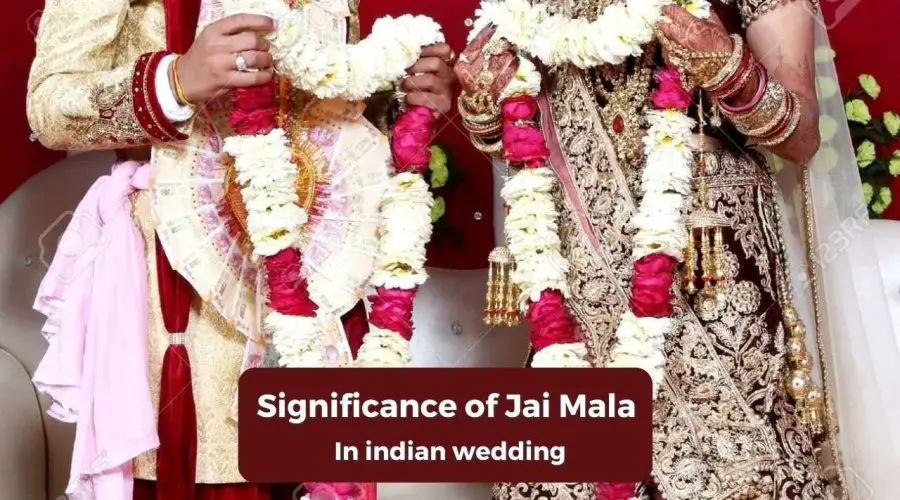Know the Significance of Jai Mala in an Indian Wedding
The bride and groom put gorgeous garlands around each other’s necks just before the wedding ceremony begins in the Indian wedding tradition of Jai Mala.
Since time immemorial, the ancient tradition of Jai Mala, also known as Varmala, has been followed and practised. You’ll note that this timeless and classic wedding tradition is frequently featured in Indian films and depicted in Indian wedding photos on the internet.
Jai Mala or Varmala has been historically and somewhat interestingly linked to how princesses chose their husbands through the process of swayamvar (swayamvar is an ancient Indian practice of choosing a husband from among a list of suitors by a girl).
If you think this is just a common ceremony, you’ll be astonished to learn that the garlands themselves, as well as the act of passing them between the bride and husband, have a very deep meaning in Hindu rituals.
Varmala Ceremony/Rituals of Jai Mala
This ceremony takes place once the groom and his baarat (wedding procession) arrive at the wedding destination. At the wedding stage, the groom is waiting for the bride to make her entrance. When the bride arrives on stage, both of them drape the Jai Mala over their necks. They have both accepted each other as partners in this marriage.
In a Hindu wedding, the exchange of garlands, also known as jai malas, is the first ceremony of unity between the bride and groom, as well as a physical expression of the two sides’ consent to marry.
What is Jai Mala made of?
Flowers are common in Jai Malas or Varmalas because they represent a variety of emotions as well as beauty, enjoyment, and excitement. White, red, yellow, green, orange, and other hues are popular for weddings in Jai Mala.
These Jai Malas are made using flowers such as jasmine, marigold, roses, orchids, carnations, and others. A traditional Jai Mala is made of jasmine flowers, roses, or marigolds. The choice of flowers used in the garland may differ depending upon the area. Red roses and white flowers are popular in north India, while marigolds and orange-coloured flowers are popular in south India
The garlands’ overall size may also change from one place to the other. Jai Malas in southern India are typically filled with flowers and are long and heavy, while Jai Malas in the north are lighter and more delicate in appearance and form.
Cash notes are used in garlands in some communities instead of fresh flowers; the cash money is considered a good luck charm for the marriage.
These days, the bride and groom opt for exceedingly opulent Varmalas made of exotic flowers like orchids and other exotic flowers. They can even choose artificially created Jai Malas, which are beneficial for those who are allergic to pollen found in actual flowers.
What’s the Significance of Jai Mala or Varmala?
A garland of flowers represents joy, beauty, excitement, enthusiasm, fervour, and aspiration. The thread that binds the flowers together serves as a container for these sensations and emotions. The married couple takes vows to stick with each other through thick and thin and share their lives with each other through mutual understanding, love, passion, respect, trust, and faith, just as the thread holds the flower together and never leaves them, even if they have lost their charm and lustre with time. The thread that binds the blossoms represents the unity created by the two souls’ marital bond.
Frequently Asked Questions
1. What is a jaimala wedding?
The Varmala Ritual, also known as Jaimala, is the first meeting between the Bride and the Groom before the wedding ceremony begins. Mala refers to a garland made out of flowers strung together on a string.
2. Who brings jaimala bride or groom?
Jaimala is a different name for it. Varmala refers to the bride and groom exchanging garlands. It is constructed of beautiful, fresh flowers. It was said to be the bride and groom’s acceptance ritual for the marriage in ancient times.
3. What does the jaimala symbolize?
After he ruptured the bow with his hand, Sita discovered a Jaimala around Lord Ram’s neck. This scene from the Ramayana depicts Sita accepting Ram as her husband.
4. Who do varmala first?
After the groom is adored (symbolically) upon his arrival, the Varmala ceremony takes place. Traditionally, the bride wraps the varmala around her soon-to-be spouse first, followed by the groom.

